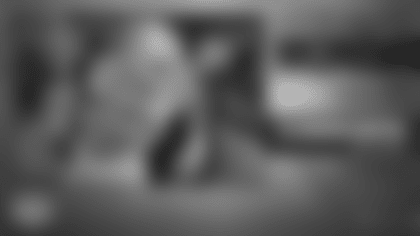The opinions expressed in this article do not reflect those of the team.
The Washington Commanders will be back at FedExField on Sunday to take on the Atlanta Falcons. Here are three keys to securing a win, presented by KIA.
1. How can Washington keep the Falcons' offense in third-and-long situations?
Logan: The answer is stopping the run. It might appear as if this is highlighted every week; it has been a point of emphasis for Washington's last handful of opponents. However, it has never been truer than it will be against the Falcons.
The Falcons' offensive identity is constructed around running the ball. They are the only team in the that has more called runs than passes, averaging 4.9 yards a carry. Chicago has more total runs, but many of them have come off scrambles.
Much like Chicago, who runs the football because they must, Atlanta tries hard to insulate quarterback Marcus Mariota. However, unlike Chicago, there is a surgical savagery to how Atlanta runs the ball.
Atlanta head coach Arthur Smith has constructed an offensive philosophy identical to his pervious stint with the Titans. Atlanta is an outside zone team, which means they attack the edges of opposing defenses, but they do so with the intent of getting defenses to move laterally and then attack downhill.
One way to stymie the outside zone is to limit the lateral movement the offense can generate. Washington does this by setting strong vertical edges. Montez Sweat might be the best in the NFL at doing this, using his length and strength to blow offenders off the ball. However, Atlanta understands how important it is to expand the defense.
Both Caleb McGary and Jake Matthews lack ideal arm length for tackles, which puts them at a disadvantage from against edge defenders like Sweat. However, Atlanta supports their tackles with their lightning quick guards. The guards sprint off the ball to edge defenders while they are engaged with the tackle, which allows them to physically widen the edge. Atlanta's right guard Chris Lindstrom is especially violent with this technique.
Double teaming the edge does come with drawbacks. Securing the perimeter with the guard forces center Drew Dalman to reach a defensive tackle. This matchup obviously favors Washington Daron Payne and Jon Allen. However, the Atlanta backfield has shown the ability to run away from a penetrating defensive tackle.
Atlanta is surgically consistent at communicating and executing what is called unlike any offensive front Washington has played this season. Jack Del Rio has seemed comfortable playing their traditional defensive structures against heavy run teams. As seen in the image below, they are playing their normal six-man structure against Tennessee's six-man blocking surface, relying on the defensive line to win one-on-one matchups.

This makes sense against a run game and quarterback like Ryan Tannehill, but Tennessee is a different animal. In the image below, Carolina has eight run defenders for Atlanta's six-man blocking surface. This shows how proficient they believe Atlanta is in the run game. It also shows how they view Mariota as a passer. Defenses do not commit these types of resources to stopping the run verses a viable passer.

I believe Washington should adopt shades of Carolina's philosophy. With Pitts out and Mariota's limitations as a passer, Del Rio can afford to allocate more resources to stopping the run. Expect to see one of the safeties in the box along with John Ridgeway at nose. This would move Allen and Payne to three techniques, preventing Atlanta's guards from helping the tackles.
Zach: Logan did a great job of explain how Washington can keep Atlanta backed up, so I will explain why: while Mariota can occasionally launch passes downfield, he doesn't do it enough to warrant much of a threat.
Logan's explanation of how Carolina crowded the box against Mariota is similar to how defenses planned for him when he was with the Titans. Sure, he had Derrick Henry in his backfield, and stopping him is a priority for any defense. But the stacked boxed were also a result of Mariota's reluctance to push the ball downfield.
While Mariota has improved as a passer since his last game for the Titans in 2018, many of his issues still exist. For example, Atlanta is tied for 25th in passes resulting in gains of 20-plus yards and tied for 23rd in receptions of at least 40 yards.
Mariota's poor throw rate (20.6%) is also the fifth highest in the league, according to Pro Football Reference, and the short list of players with a highest rate includes Zach Wilson and Davis Mills.
If Washington can force Mariota into passing situations, the secondary should feast on these errant throws.
2. What can Washington do to have success against defensive coordinator Dean Pees philosophy?
Logan: Defensive coordinator Dean Pees comes from the Baltimore coaching tree, which is characterized by exotic, high-volume blitz packages. Notable disciples include Wink Martindale, the current defensive coordinator for the New Your Giants, and defensive coordinator/ head coach Rex Ryan.
When Pees left Baltimore for Tennessee, he carried this aggressive style with him, but that philosophy has changed in Atlanta. Instead of being aggressive like he was in Baltimore and Tennessee, Pees has shifted to a "bend but don't break" approach. He plays multiple versions of cover three spot drop, quarters, Tampa 2, and a sprinkle of man coverage on early downs.
These coverages, specifically cover 3 and cover 4, allow the defense to be relatively stout while allocating more resources to the run. The spot drop element of these coverages, meaning dropping to a landmark on the field as opposed to trying to match concepts, are designed to force offenses to check the ball down. Pees' approach is one that assumes offenses will incur a penalty or drop a pass to stall the drive.
Pees' philosophy shifts slightly on third down. He does become more aggressive with regards to pressure, but he is nowhere near what he was in Tennessee. His coverage approach shifts to running a higher percentage of man defense. He finds ways to double players and free up his safeties to make plays on the ball. It is not earth shattering, but it shrinks throwing windows and puts stress on the quarterback.
So, how do the Commanders beat it? The answer is simple: be patient and be efficient. Washington will still try and run the football, which is smart. It limits the thing this style of defense does best, which is make quarterbacks bored.
Indianapolis engaged a similar approach against Washington, forcing Taylor Heinicke to check the ball down to the backs. Eventually, Heinicke tried to make a play on a tight window throw which led to an interception.
This mistake was not surprising; in fact, the defense is counting on it. As a result, Scott Turner needs to make sure Heinicke has somewhere to go with the football when the coverage is taking away deep throwing windows. Both Turner and Heinicke also need to understand that it is OK if they punt in this game.
Atlanta's offense is efficient at running the football, but that doesn't traditionally lead to high scoring affairs. Combine that with the Commanders' success on defense against the run and Turner needs to be OK calling a boring game. That might not be an exciting answer, but the defense is the star of the show now. Turner and Heinicke need to do everything in their power to limit costly errors by the offense and rely on the defense to win the game.
Zach: To me, the focus for the Commanders needs to be similar to the game plan against the Eagles and Texans, which is to put less of a strain on Heinicke and put him in advantageous situations to get the ball to his playmakers.
This was particularly true against the Texans, when Heinicke threw a season low 27 passing attempts. His stats were not gaudy, but several of his completions, like his 13-yard pass to Jahan Dotson in the first quarter, helped ignite the offense when it needed to score. It was also the first time all season that Heinicke did not commit a turnover.
Logan mentioned Indianapolis' success using a similar defensive philosophy to that of Atlanta against Heinicke, but I believe Washington's shift to leaning more on the running game will eliminate opportunities for those mistakes. Washington ran the ball 28 times against the Colts, six of which were scrambles from Heinicke. Over the last two games, Washington has run the ball 49 and 40 times.
As for Pees' using more man coverage on third down, I'm not so worried about that because of how effective Washington's receivers are against man coverage. Heinicke's trust in Terry McLaurin might lead to him forcing passes into coverage, but as long as he does a good job of distributing the ball -- seven other players besides McLaurin were targeted -- he should be able to continue his streak of doing enough in the passing game to win.
One of the ways Washington can do that is by giving McLaurin and other receivers route with a high success rate. Take McLaurin as an example; he excels at slant route because of his ability to get separation at the line of scrimmage. He used to dislike slant routes, but now it is one of the strongest parts of his game.
"Somehow, some way, he's going to catch it," Turner said. "There's a high level of confidence that I have that he's going to end up with the ball at the end of it."
3. Who is a player to watch on Sunday?
Logan: This is an easy one: Cordarrelle Patterson.
Patterson has provided a spark for this team. He has been in and out of the lineup with an injury, but when he has been healthy, he has been a catalyst for explosive plays.
Prior to Pitt's injury, he and Drake Loudon were the primary weapons in the passing game. While both are exceptional athletes and physical monsters, neither one is particularly explosive. Patterson has been able to provide the explosive play spark. He has a great feel for how to run the outside zone. He makes for a dangerous weapon, especially for a team that has such a conservative offensive approach.
Atlanta also does a good job moving him around the formation. He doesn't run a complicated route tree, but he is a mismatch weapon because of his speed. Smith does a good job trying to find Patterson touches in space where can create after the catch, much like Turner does with Antonio Gibson.
However, Patterson has a better pedigree at receiver than Gibson playing as a true X receiver. Patterson lined up outside last year against the Commanders and was able to exploit the defense for an explosive touchdown.
It wasn't his route running that allowed him to make the play, but rather his raw athleticism and ball skills. With Pitts out, it will be interesting to see if Smith increased his usage in the passing game.
Patterson's combination of size and speed make him a challenging matchup. The Commanders need a plan for him, and I can't wait to see what it is.















